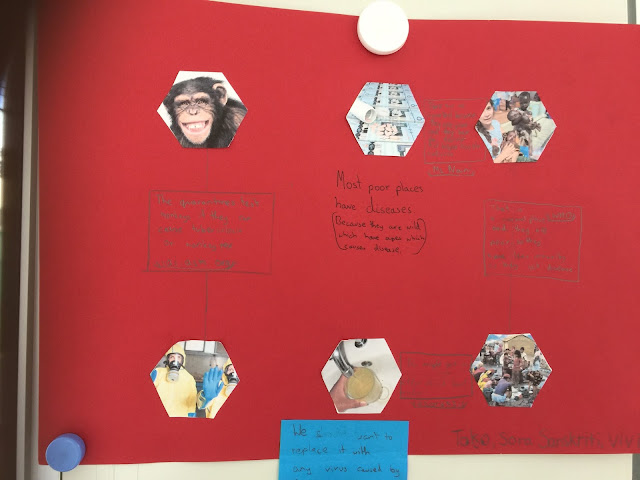Students were given 6 hexagons to work with.
They were allowed to look for case studies and evidence to support their connections.
1) I added one hexagon that didn't quite seem to fit in with the rest. Another one was there to promote cognitive dissonance- a feeling of discomfort which may stop them from making certain connections. (They may not find it easy to digest the fact that some people eat apes.)
2) Next, I asked them to make a generalization about diseases based on the connections they made. What was a recurring pattern that could prompt them to come up with a big idea.
3) And finally, which one hexagon would they remove and what could they replace it with. They of course had to give reasons. We kept asking "So what?" to help them build their reasoning. Tweaking an old strategy helped . The students had to make decisions.
This group tried a linear approach and wanted to make connections with each hexagon. They ended up using a cyclical model. When they did that, the structure allowed them to make yet another powerful connection: the vicious nature of the cycle of poverty. Aid helps developing countries recover and yet because of the unhygienic environment people live in, the people are always susceptible to diseases.
The purple group also made a cyclical connection.
The yellow group placed human aid at the centre. They struggled to make a generalization.and now will reflect on what they could have done in order to make it easier to come to a big understanding.
The green group thought water was they key factor but found it hard to connect the hexagons in a way that made sense to them. As a result their generalization came after a long, battled discussion. Nevertheless, they kept trying and came up with one!
Trading a Hexagon
One group decided to get rid of the dirty water as they could not find a good connection the chimpanzee. They would change it for a picture of the Ebola virus.
Another group wanted to change they Chimpanzee for a picture of an ape in a science lab (being used by scientists to discover cures for the virus). Great thinking involved.
As the students worked, I worked alongside them and came up with some startling facts. This is a fun activity and my students and I never tire of it.
It is expensive to set up a quarantine. It costs almost $1000 a day!
I learnt that poor countries get around 1.3 trillion dollars in aid...and here I was stumped... The Guardian claims that almost 3.3 trillion dollars move out from poor countries to the rich ones! Who was helping who! I would replace the hexagon with dirty tap water with a bank note and see how my inquiry goes with that! It may move away from diseases and inch towards global economics!
This activity allowed students to use their knowledge of diseases. Along with certain trans disciplinary skills, communication and thinking skills, they were able to make generalizations. Some may not have been very successful at it, yet the recognized a good one when they heard it.!
"Most people in poor societies cannot afford proper (health) care, so they require on help from other."
(Harumi, Someno, Linnea- Grade 6B Thinkers)






Comments
Post a Comment
Thank you for taking the time to read my blog.